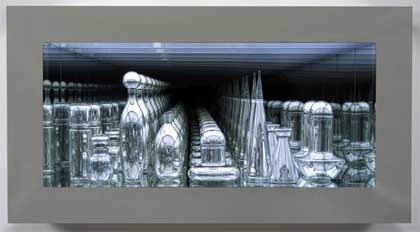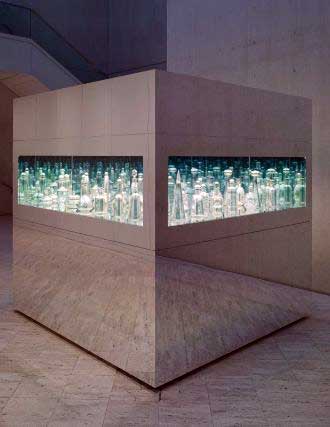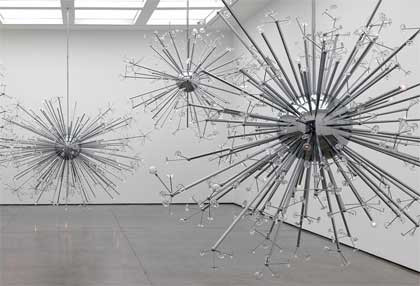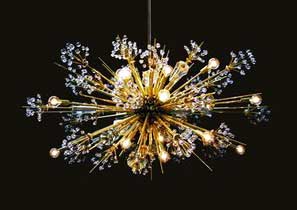Institute of Contemporary Art / Boston
June 22 – October 14, 2012

“Czech Modernism Mirrored and Reflected Infinitely” (2005)
Mirrored glass case with hand blown mirrored glass objects
18 ½ x 56 ½ x 30 ½ inches (47 x 143.5 x 77.5 cm)
Image courtesy of Institute of Contemporary Art / Boston
The silver bottle sculpture outside the book store at the MFA was always an attention-getter since its installation some years back. It was never quite clear how the creator did it. Were those actual silver bottles inside the box that displayed all of those endless repetitions, or was it some kind of hologram?

“Endlessly Repeating Twentieth Century Modernism”
© Josiah McElheny 2007
Image courtesy of Museum of Fine Arts, Boston
Josiah McElheney, the creator of that piece – Endlessly Repeating Twentieth Century Modernism (2007) – now struts a whole range of different things in his one-person show at the ICA.
After a few preliminary glass models on entering the exhibit, one sees a piece much like the one at the MFA. Entitled Czech Moderne Mirrored and Reflected Infinitely (2005), it seems not quite as big or as elaborate as the MFA piece, but utilizes essentially the same effect: an echoing of silver bottles in an endless array of internal reflections, equally magical.
But we now learn, through this exhibit, that the formerly elusive effect is produced by bottles that are indeed blown glass and that these are positioned within a sequence of mirrors that creates the shimmering illusion.
Several other versions inspired by the same technique, in open rather than closed cases, are entitled as different elements of a Scale Model for a Totally Reflective Landscape. The open view lets one peer inside the pieces a bit more and see what is going on.
Another room is filled with three large mirrored screens upon each of which is projected short experimental films, collectively entitled Three Screens Looking for An Abstraction (2012). These screens are somewhat varied: one is simple and angular, another boxy, another looks like the folded paper fortune-teller often made by children. Approaching this room from the next, I heard some mellifluous chamber music, but when I entered, the sound track from another of the films came on, with loud monotonous humming and staticky accompaniment that encouraged accelerated forward movement.

Image courtesy of Institute of Contemporary Art / Boston
Island Universe (2008) is the big piece in the exhibition. It consists of five large metallic (aluminum) constructions with various glass brances, stems and bulbs.
I noted that these chandelier-like pieces looked a lot like the chandeliers at the Metropolitan Opera House in New York. That’s pretty derivative! I thought. And then, when reading the wall blurb about the piece, I learned that McElheney actually did derive his inspiration for the piece from those chandeliers at the Met designed by the company J. & L. Lobmeyr. And, not only was that inspiration noted in passing, but there was a whole film in the other room, done by McElheney, about those Metropolitan Opera chandeliers. So much for my preliminary rush to judgment.

Designed by Hans Harald Rath of J. & L. Lobmeyr
In this piece, McElheney has taken the basic idea of those chandeliers and used them to do some quite involved cosmic modeling. He bases each of the five pieces on a different cosmological view of the universe, taking the underlying inspiration of the multiple universe idea from the model of multiple universes put forward first in the 1980s by the Russian cosmologist Andrei Linde.
In this fairly detailed representational model, glass globes and disks apparently represent clusters of galaxies and lightbulbs represent quasars.
All of this was interesting, but it struck me that the carefully wrought representational approach made these pieces a little too like the sorts of graphic displays that Edward Tufte discusses in his 1983 classic, The Visual Display of Quantitative Information. Why does McElheney feel so moved to create such discretely scientific models? In the end, the inspiration and the idea are conceptually interesting, but the effect is a little cold.
On the other hand, the multiple endless bottle sculptures, though steely and remote in a certain way, are a lot of fun. The playing around with the endless reflections layers amusement on top of sleek and silvery construction materials. In their own way, these combinations reflect a bright and ironic sense of levity against the metallic coolness of the cosmos upon which they play.
Island Universes, though inspiring in its dedication to be dutifully representational as well as cosmic, spins away from the fun. The great thing about those chandeliers by J. & L. Lobmeyr at the Metropolitan Opera is how precise and delicate they are, but also how they move and create that extra bit of drama just before a performance. They have an austere and cosmic elegance about them, but they move with a kind of whimsical grace. That combination of fancy and precision – much like McElheny’s reflected bottle sculptures – makes for the warmth and pleasure they have delivered during the last half-century at Lincoln Center.
When McElheney’s work shows that kind of dramatic fun, his poetry comes to life. It shines when he aims for this gentle lyricism in the play of reflection. His attempt at the cosmic and the epic results in a music of the spheres that has less of a beat.
– BADMan
Leave a Reply